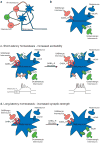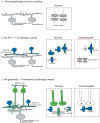Mechanisms underlying spontaneous patterned activity in developing neural circuits
- PMID: 19953103
- PMCID: PMC2902252
- DOI: 10.1038/nrn2759
Mechanisms underlying spontaneous patterned activity in developing neural circuits
Abstract
Patterned, spontaneous activity occurs in many developing neural circuits, including the retina, the cochlea, the spinal cord, the cerebellum and the hippocampus, where it provides signals that are important for the development of neurons and their connections. Despite there being differences in adult architecture and output across these various circuits, the patterns of spontaneous network activity and the mechanisms that generate it are remarkably similar. The mechanisms can include a depolarizing action of GABA (gamma-aminobutyric acid), transient synaptic connections, extrasynaptic transmission, gap junction coupling and the presence of pacemaker-like neurons. Interestingly, spontaneous activity is robust; if one element of a circuit is disrupted another will generate similar activity. This research suggests that developing neural circuits exhibit transient and tunable features that maintain a source of correlated activity during crucial stages of development.
Figures


References
-
- Owens DF, Kriegstein AR. Is there more to GABA than synaptic inhibition? Nat Rev Neurosci. 2002;3:715–727. - PubMed
-
- Spitzer NC. Electrical activity in early neuronal development. Nature. 2006;444:707–712. - PubMed
-
- Galli L, Maffei L. Spontaneous impulse activity of rat retinal ganglion cells in prenatal life. Science. 1988;242:90–1. - PubMed
-
- Meister M, Wong RO, Baylor DA, Shatz CJ. Synchronous bursts of action potentials in ganglion cells of the developing mammalian retina. Science. 1991;252:939–43. - PubMed
-
- Tritsch NX, Yi E, Gale JE, Glowatzki E, Bergles DE. The origin of spontaneous activity in the developing auditory system. Nature. 2007;450:50–5. - PubMed
Publication types
MeSH terms
Substances
Grants and funding
LinkOut - more resources
Full Text Sources
Miscellaneous

